
It seems like everywhere I’ve turned over the past couple of years, I was almost guaranteed to see a wireless Bluetooth speaker. What was once more of a niche market has become quite crowded with many excellent products on offer for us to choose from. So if you’re Roland, the famed instrument and electronics manufacturer, how do you navigate entry into this growing market? The answer is that you release the BTM-1 Bluetooth Speaker and add a guitar input to it in a way that, not-so-oddly, makes a whole lot of sense.
If you play guitar at any level, you are at the core a lover of music, and by including a ¼ inch jack on an already high-quality Bluetooth speaker, you can combine the instrument and the music in a way that simply makes both better. You can finally start learning that song you love by easily switching between listening to it and then playing it until you’re ready to jam right along with it. You can also play away the hours by practising your scales or thrashing out some aggression, and then when you just want to relax and listen to music in your headphones, the BTM-1 has got you totally covered.
Bluetooth Music Speaker
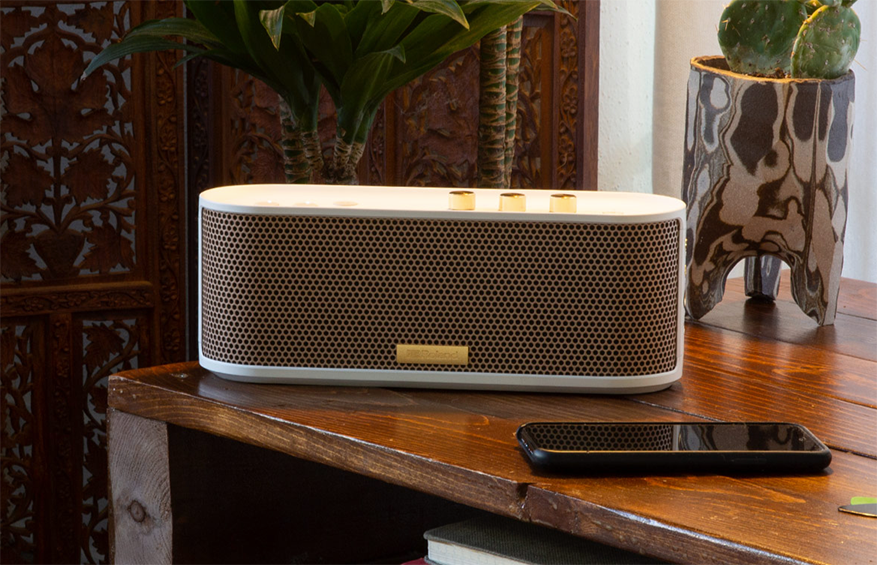 The Roland BTM-1 is simultaneously many things, but at its core it is a very decent wireless speaker for streaming music. Roland’s custom speakers are the lifeblood of this small yet powerful unit. Music, whether played from my smartphone through the aux input or over Bluetooth, was clear, had decent bass, and was remarkably quite loud for two passive 2-inch speakers. Obviously not loud enough to provide music for a wedding reception, but loud enough for background music when you have a few friends over for a dinner party. When I “cranked it,” I was surprised that the music did not simply distort as it is clearly designed to max the volume before it starts to break apart.
The Roland BTM-1 is simultaneously many things, but at its core it is a very decent wireless speaker for streaming music. Roland’s custom speakers are the lifeblood of this small yet powerful unit. Music, whether played from my smartphone through the aux input or over Bluetooth, was clear, had decent bass, and was remarkably quite loud for two passive 2-inch speakers. Obviously not loud enough to provide music for a wedding reception, but loud enough for background music when you have a few friends over for a dinner party. When I “cranked it,” I was surprised that the music did not simply distort as it is clearly designed to max the volume before it starts to break apart.
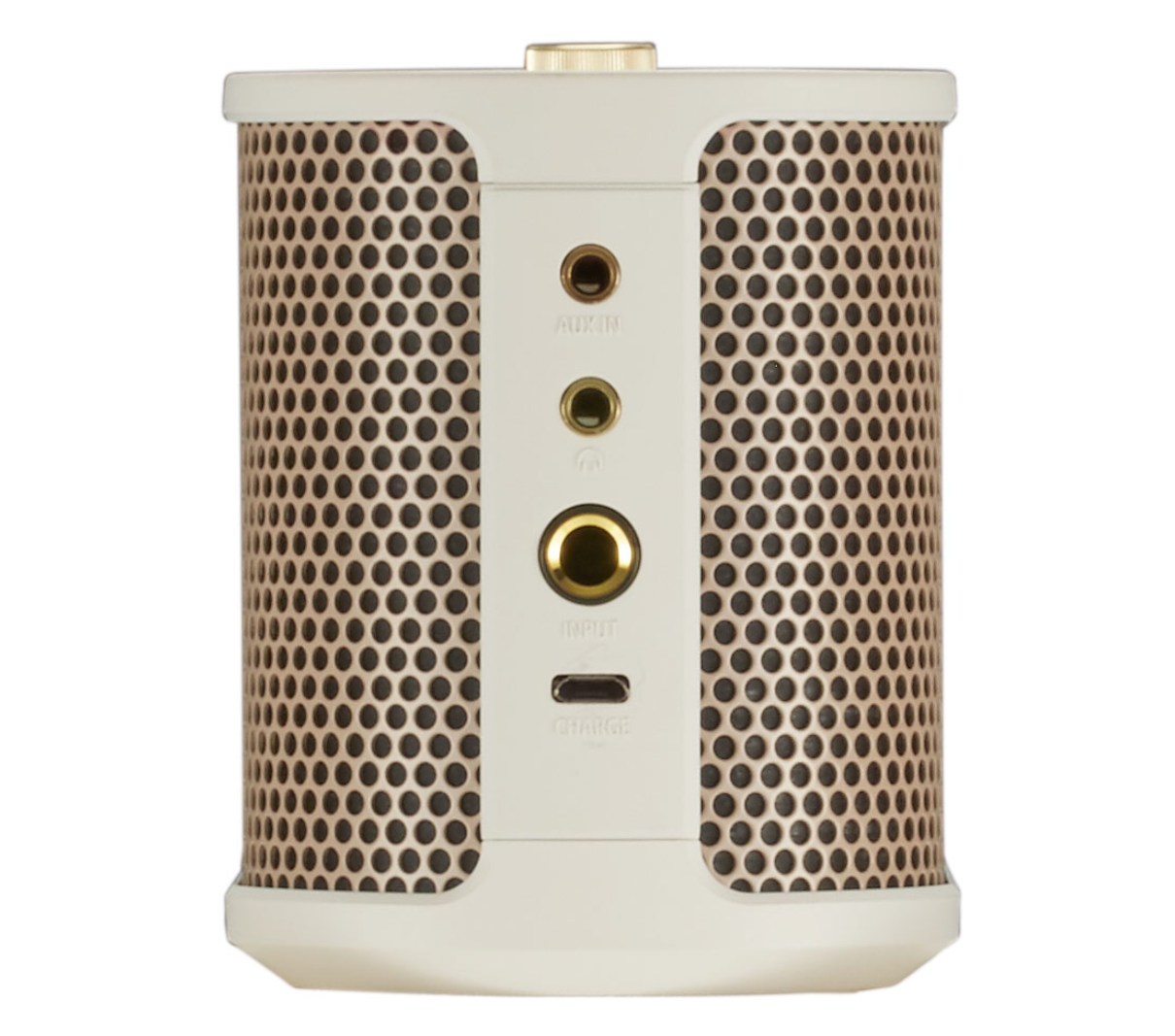 It has a built-in battery that charges when connected via USB to power (or a computer), so you can grab it and take it with you when the need to hit the road overtakes you. I didn’t use it long enough to know exactly how long the battery does last, but Roland claims that you can get 6 hours of continuous use when streaming music via Bluetooth.
It has a built-in battery that charges when connected via USB to power (or a computer), so you can grab it and take it with you when the need to hit the road overtakes you. I didn’t use it long enough to know exactly how long the battery does last, but Roland claims that you can get 6 hours of continuous use when streaming music via Bluetooth.
Aesthetically, it has that retro, “mid-century” vibe that is all the rage these days. The colouring is cream and tan with gold hardware and is exactly the wireless Bluetooth speaker I would have expected to see in the Jetsons’ home. The controls are on the top of the unit with the power, Bluetooth, and volume buttons on the left side. On the top right are the three dials for use with a guitar. These are Gain, Tone, and Level. There is also an “FX” button to employ the echo/delay. Down the right side are the inputs. From the top down, there is a 3.5mm AUX input, a 3.5mm headphone input, a ¼ inch guitar input, and a USB micro-B charging port.
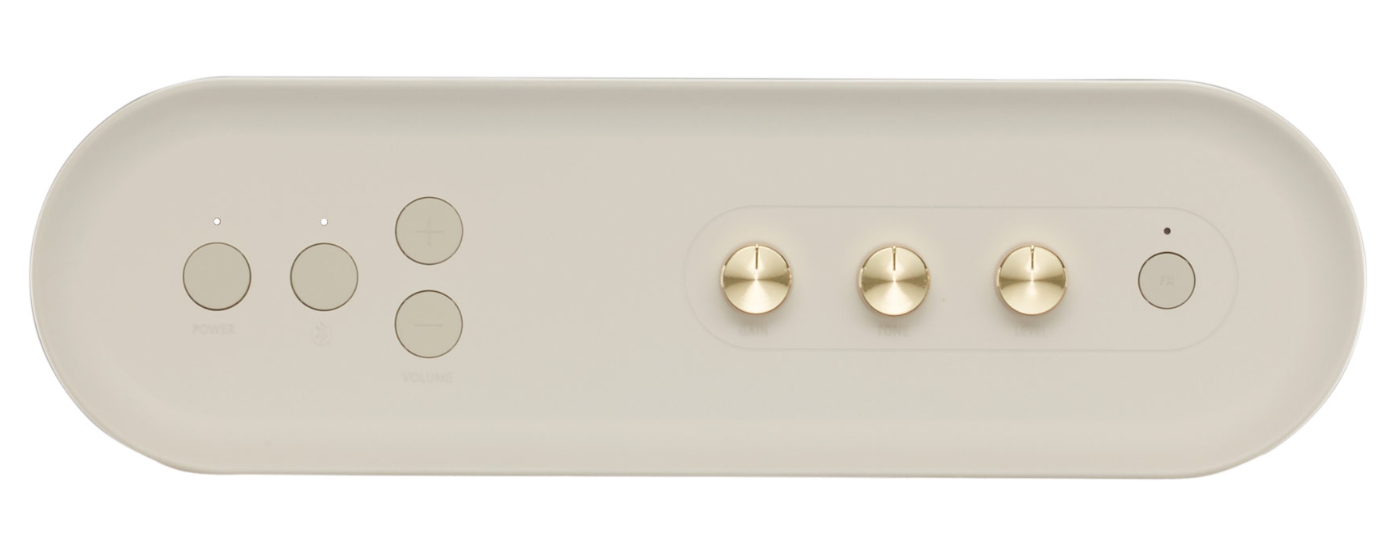 The Roland BTM-1 is incredibly easy to pair with a device over Bluetooth. With the power turned on, simply hold down the Bluetooth button for a couple of seconds until the light flashes faster. At this point, go to your device’s Bluetooth settings and select the BTM-1 from the list and… I said it was simple. Once you’ve paired it, your device should remember it, as every time I went to use it, my phone was automatically paired.
The Roland BTM-1 is incredibly easy to pair with a device over Bluetooth. With the power turned on, simply hold down the Bluetooth button for a couple of seconds until the light flashes faster. At this point, go to your device’s Bluetooth settings and select the BTM-1 from the list and… I said it was simple. Once you’ve paired it, your device should remember it, as every time I went to use it, my phone was automatically paired.
Roland BTM-1 as a Guitar Amp
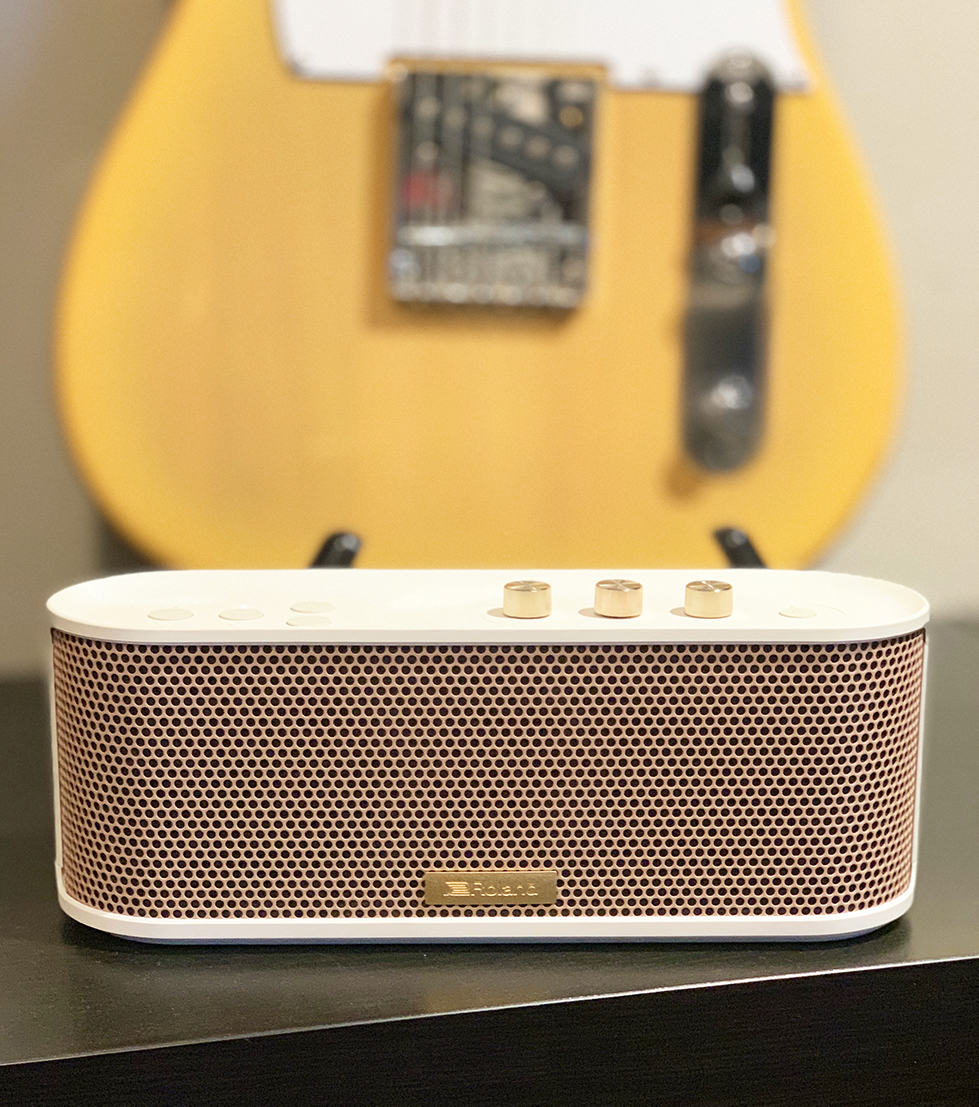 So, in addition to being a wireless Bluetooth speaker, the Roland BTM-1 stakes its claim in the market by adding the ability to play your guitar through it. Perhaps even more significantly, to play your guitar with it. You can, in fact, stream a song over Bluetooth—or via an audio cable connected to the AUX input, and play your guitar along to the song. This is an amazing tool for learning songs as well as perfecting them. In my use of the unit, there was absolutely no latency between what I was playing and what I heard, which is, of course, key to playing along with songs.
So, in addition to being a wireless Bluetooth speaker, the Roland BTM-1 stakes its claim in the market by adding the ability to play your guitar through it. Perhaps even more significantly, to play your guitar with it. You can, in fact, stream a song over Bluetooth—or via an audio cable connected to the AUX input, and play your guitar along to the song. This is an amazing tool for learning songs as well as perfecting them. In my use of the unit, there was absolutely no latency between what I was playing and what I heard, which is, of course, key to playing along with songs.
The BTM-1 has built-in overdrive (distortion) and delay (echo). The gain dial controls the amount of overdrive you want on your guitar signal, and truth be told, it can get pretty dirty sounding. I confess that the first time I played my guitar through it and started to turn up the gain, I was pleasantly shocked at how metal it could sound. Shocked I say! The tone dial lets you suck out the mid-tones for some deeper sludge sounds, or you can brighten it right up by adding some sparkly highs. The level adjusts the volume of the guitar sound only and is how you can get the mix you need when playing along with a track.
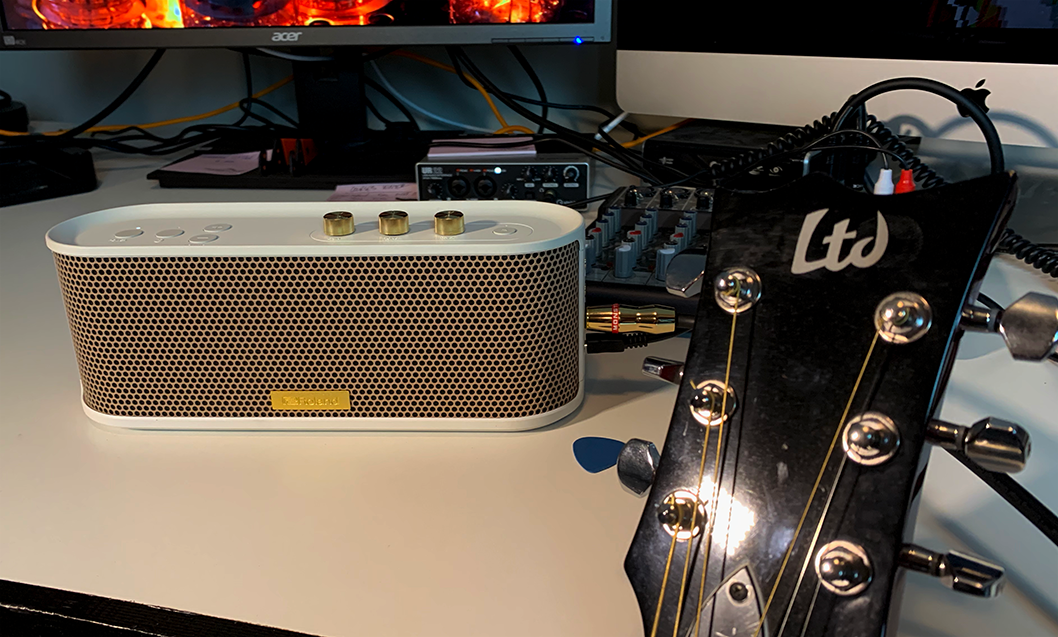 The FX button turns the echo/delay effect on or off. I didn’t realize this at the time that I recorded the accompanying video, but, in the owner’s manual, I saw that if you press and hold the FX button and then press the volume up button, you get the “high” overdrive. Conversely, pressing the FX button with the volume down switches to “low” overdrive. There is a significant difference between these two overdrive settings, and again, you can personalize them even more with the gain and tone dials. So, all in all, you get a fair amount of flexibility for a device of this size and with this ease of use.
The FX button turns the echo/delay effect on or off. I didn’t realize this at the time that I recorded the accompanying video, but, in the owner’s manual, I saw that if you press and hold the FX button and then press the volume up button, you get the “high” overdrive. Conversely, pressing the FX button with the volume down switches to “low” overdrive. There is a significant difference between these two overdrive settings, and again, you can personalize them even more with the gain and tone dials. So, all in all, you get a fair amount of flexibility for a device of this size and with this ease of use.
Other Considerations
 The Roland BTM-1 is NOT a smart speaker on its own; it can’t control your TV or lights, or answer any nagging trivia questions for you. If that is something that you are looking for, then I might suggest that, as I did, you can easily connect a device to it for just that purpose. I plugged my Amazon Echo Dot (3rd Generation) into the AUX jack, and when Alexa talks to me, I hear it through the BTM-1. When I ask Alexa to play music, it plays through the BTM-1. So, for next to nothing you can ostensibly convert your Roland BTM-1 into a smart device. I realize, of course, that it is the Echo that is the “smart device,” but when Alexa talks to me through the far superior BTM-1 speakers, it is like I got a serious upgrade of my already pretty sweet smart device.
The Roland BTM-1 is NOT a smart speaker on its own; it can’t control your TV or lights, or answer any nagging trivia questions for you. If that is something that you are looking for, then I might suggest that, as I did, you can easily connect a device to it for just that purpose. I plugged my Amazon Echo Dot (3rd Generation) into the AUX jack, and when Alexa talks to me, I hear it through the BTM-1. When I ask Alexa to play music, it plays through the BTM-1. So, for next to nothing you can ostensibly convert your Roland BTM-1 into a smart device. I realize, of course, that it is the Echo that is the “smart device,” but when Alexa talks to me through the far superior BTM-1 speakers, it is like I got a serious upgrade of my already pretty sweet smart device.
Also important to remember is that we are talking about a unit that stands just 4 inches tall, measures just over 10 inches wide, is 3 inches deep, and weighs a scant 2 pounds. As such, you can’t roll into a band practice with this and hope to compete with drums for auditory space. The BTM-1 is not a gigging amp, but on the nightstand in your bedroom, it is a perfect little practise amp.
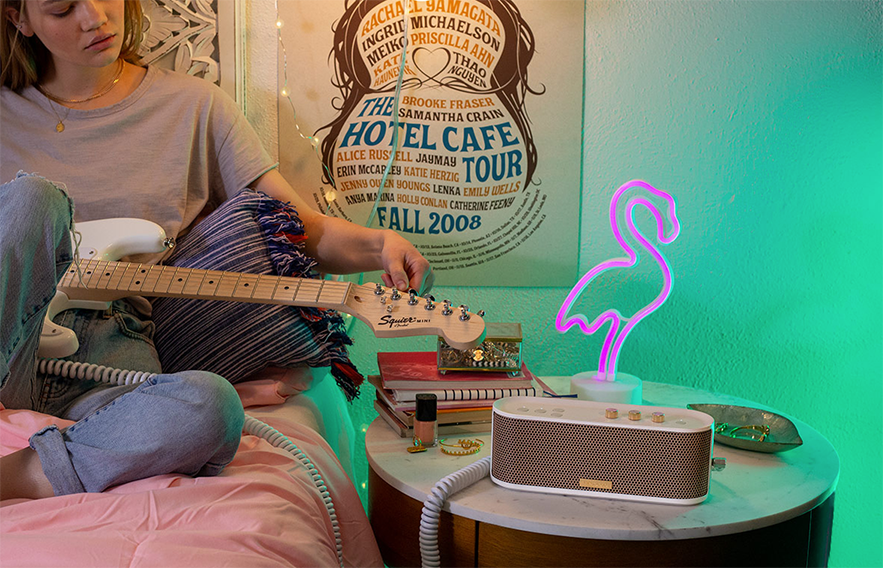
Conclusions
The Roland BTM-1 is a decent Bluetooth speaker for streaming music, and it comes in an aesthetically pleasing retro looking package with a fairly compact footprint. Where it really shines—and what truly sets it apart, happens when you plug in the guitar. From creamy clean tones to gritty distortion and everything in between, The Roland BTM-1 would be a welcome addition to any room, including a bedroom. In fact, it’s all you would need in your bedroom to let you listen to music as well as work on your guitar chops, even doing both at the same time.
Roland BTM-1 is available at Best Buy.




Ian, that is a great point and one I wish I had thought of. In theory I know there are issues with some guitar speakers handling deep bass although plenty of bass players do it, Lemmy for example. The speakers on the BTM-1 are so small compared to traditional guitar and bass amps that i’d be afraid that some deep bass would simply shred the speaker. On second thought I don’t think I’d try it but if you do, let me know how it goes 🙂
When reviewing guitar gear In the future I will try and remember to plug in my bass as well, when relevant. Thanks!
This sounds like a great speaker. One thing I’d like to find out though is about that guitar input. I know that amps are not necessarily designed to be used by both guitars and bass guitars. I’m a bass player and am interested how this speaker works with them.
Comments are closed.